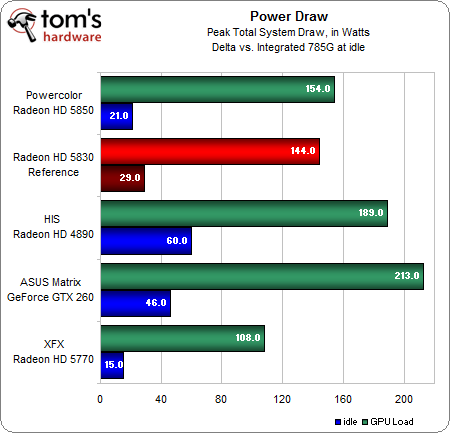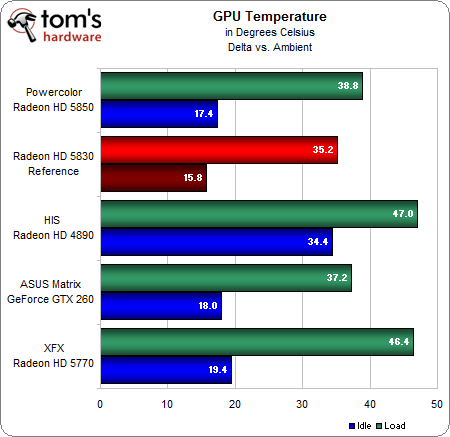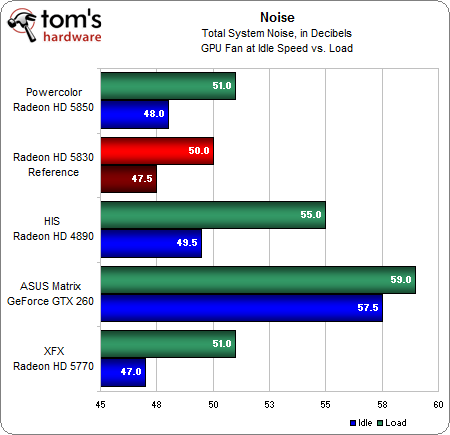ATI Radeon HD 5830: Bridging The 5700- And 5800- Price Gap
Power, Temperature, And Noise Benchmarks
There are a few surprises in the power usage tests. The new Radeon HD 5830 does use a few more watts than the Radeon HD 5850 at idle, likely due to the Radeon HD 5870 PCB on which our reference card is built. But, under load, the new card doesn't seem to be as stressed.
This is the opposite result that we expected after looking at AMD's specifications, which suggest the 5830 uses less power at idle and more under load. We're also surprised to see the Radeon HD 4890 drawing less power than the GeForce GTX 260 sample we have on-hand. The Asus ENGTX260 Matrix is a non-reference card, so we're not sure if optimization on Asus' end has anything to do with the result. However, we expected the Radeon HD 4890 to pull more watts than its competition.
Notice how little power the Radeon HD 5770 uses in comparison, an impressive result for a card that performs relatively closely to the new Radeon HD 5830.
All of these temperatures are well within reasonable limits. It is notable that the new Radeon HD 5830 produces much less heat than the other cards, despite the fact that it is saddled with a reference cooler. Then again, it makes sense when you consider that this reference cooler was designed to keep the powerful Radeon HD 5870 cool enough under load. Also note that the Asus GeForce GTX 260 is brandishing a powerful non-reference cooler and is achieving very low temperatures.
The Radeon HD 5830 generates surprisingly little noise, probably because the Radeon HD 5870 reference cooler doesn't need to spin very fast in order to keep things cool. Here, the Radeon HD 5830 offers a significant benefit compared to the notably-noisier Radeon HD 4890.
Get Tom's Hardware's best news and in-depth reviews, straight to your inbox.
Current page: Power, Temperature, And Noise Benchmarks
Prev Page Benchmark Results: Left 4 Dead And AA/AF Next Page ConclusionDon Woligroski was a former senior hardware editor for Tom's Hardware. He has covered a wide range of PC hardware topics, including CPUs, GPUs, system building, and emerging technologies.
-
jomofro39 I love my 4890. I am sad they are disappearing, because I planned on getting a x-fire thing going in the next few months, and now I have to just try and get two 5770s and sell the 4890 I have now, obviously, so I can grab some DX11! Hurray for progress!Reply -
meluvcookies I was hoping this would be just a bit cheaper such that the 5850 could finally come down nearer it's original MSRP. Unfortunately, it doesn't look like we'll see those adjustments until closer to the summer.Reply -
4745454b To much money for such little card. Performance wise its just a really expensive 4890. A good buy at $200, but $240 is to much. Might as well pony up the extra $60 and get the 5850. 5810 is a bit more like it.Reply -
flyinfinni seems more like a 5790 than a 5830 to me... Still- they are filling in the line quite well, and its gonna be interesting to see how Nvidia's new line will compare.Reply -
intelx im a little disappointed about this one, i mean 239 and yet the 4890 is $40 cheaper and beats it in some new games, i was really hoping for better performance form the 5830, now after reading this, im leaning towards either 5770 in crossfire or single 5850.Reply
man ati is kicking Nvidia in every corner right now, all the way from low end to the high end 5970! -
intelx im a little disappointed about this one, i mean 239 and yet the 4890 is $40 cheaper and beats it in some new games, i was really hoping for better performance form the 5830, now after reading this, im leaning towards either 5770 in crossfire or single 5850.Reply
man ati is kicking Nvidia in every corner right now, all the way from low end to the high end 5970! -
acasel Where is the overclocking portion? If this thing overclocks good then it might be a worthy purchase..Reply -
Aircraft123 This article definitely made me feel better about my dual XFX 4890 CrossFire setup. Performance is theoretically around a GTX295 for less money than a single 5870!!!Reply
if the 5830 can come down to ~$200 and offer good crossfire performance perhaps with good overclocking potential I can see this card do very well. -
notty22 ATI managed to cripple all the magic out of a 5850 with this thing.Reply
A gtx260 beats it in places and its only 10% faster than a 5770, thats 70 dollars cheaper ? Thanks , but NO Thanks. -
porksmuggler I've been waiting for this review, thanks Don. With the 4890 and 4850X2 still floating around for sale, this one isn't appealing even at $200. Performance is just too close to the 5770...Reply


